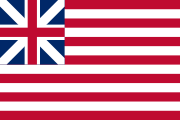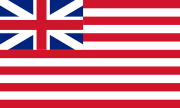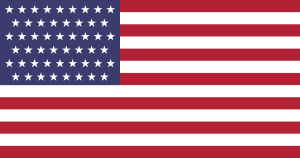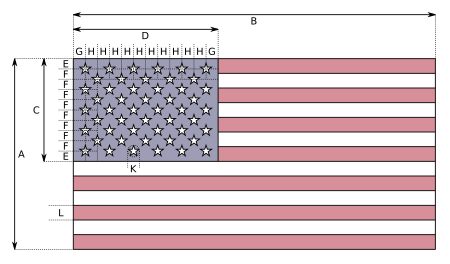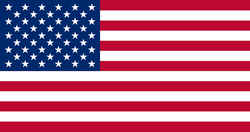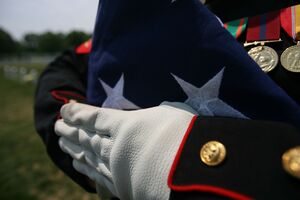علم الولايات المتحدة
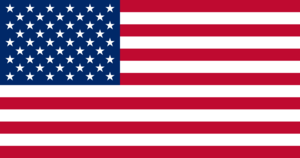 | |
| أسماء أخرى | العلم الأمريكي,
|
|---|---|
| الاستخدام | علم وشارة وطنية |
| النـِسـَب | 10:19 |
| اِعتـُمِد |
|
| التصميم | ثلاثة عشر خطاً أفقياً متناوباً بين الأحمر والأبيض؛ وفي مكان الشعار، 50 نجمة بيضاء بأعداد متناوبة من ستة وخمسة لكل صف أفقي على خلفية زرقاء |
| صممه | روبرت هفت (النسخة ذات 50 نجمة)[1] |
علم الولايات المتحدة الأمريكية أو العلم الأمريكي، هو العلم الوطني للولايات المتحدة. يتكون العلم من ثلاثة عشر خطاً أفقياً متساوياً من اللون الأحمر (أعلى وأسفل) بالتناوب مع الأبيض، مع مستطيل أزرق في مكان الشعار (يُشار إليه تحديداً "بالاتحاد") يحمل خمسين نجمة بيضاء صغيرة خماسية ارلؤوس، مرتبة في تسعة صفوف أفقية متباعدة، حيث تتناوب صفوف من ستة نجوم (أعلى وأسفل) مع صفوف من خمسة نجوم. تمثل النجوم الخمسون على العلم الولايات الخمسين للولايات المتحدة، بينما تمثل الخطوط الثلاثة عشر المستعمرات البريطانية الثلاث عشرة التي أعلنت استقلالها عن مملكة بريطانيا العظمى، وأصبحت أولى الولايات في الولايات المتحدة.[2] تشمل الألقاب التي تُطلق على العلم النجوم والخطوط،[3][4] المجد القديم،[5] والراية ذات النجوم المتلألئة.
التاريخ
The current design of the U.S. flag is its 27th; the design of the flag has been modified officially 26 times since 1777. The 48-star flag was in effect for 47 years until the 49-star version became official on July 4, 1959. The 50-star flag was ordered by then president Eisenhower on August 21, 1959, and was adopted in July 1960. It is the longest-used version of the U.S. flag and has been in use for over 65 years.[6]
علم الاتحاد
The Continental Colors
(aka the "Grand Union Flag")Flag of the British East India Company, 1707–1801
At the time of the Declaration of Independence in July 1776, the Continental Congress would not legally adopt flags with "stars, white in a blue field" for another year. The flag contemporaneously known as "the Continental Colors" has historically been referred to as the first national flag.[7]
The Continental Navy raised the Colors as the ensign of the fledgling nation in the American War for Independence—likely with the expedient of transforming their previous British red ensigns by adding white stripes—and used this flag until 1777, when it formed the basis for the subsequent designs.[7][8]
The name "Grand Union" was first applied to the Continental Colors by George Preble in his 1872 history of the U.S. flag.[8]
The flag closely resembles the British East India Company flag of the era, and Sir Charles Fawcett argued in 1937 that the company flag inspired the design.[9] Both flags could have been easily constructed by adding white stripes to a British Red Ensign, one of the three maritime flags used throughout the British Empire at the time. However, an East India Company flag could have from nine to 13 stripes and was not allowed to be flown outside the Indian Ocean.[10] Benjamin Franklin once gave a speech endorsing the adoption of the company's flag by the United States as their national flag. He said to George Washington, "While the field of your flag must be new in the details of its design, it need not be entirely new in its elements. There is already in use a flag, I refer to the flag of the East India Company."[11] This was a way of symbolizing American loyalty to the Crown as well as the United States' aspirations to be self-governing, as was the East India Company. Some colonists also felt that the company could be a powerful ally in the American War of Independence, as they shared similar aims and grievances against the British government tax policies. Colonists, therefore, flew the company's flag, to endorse the company.[12]
However, the theory that the Grand Union Flag was a direct descendant of the flag of the East India Company has been criticized as lacking written evidence.[13] On the other hand, the resemblance is obvious, and a number of the Founding Fathers of the United States were aware of the East India Company's activities and of their free administration of India under Company rule.[13] In any case, both the stripes (barry) and the stars (mullets) have precedents in classical heraldry. Mullets were comparatively rare in early modern heraldry, but an example of mullets representing territorial divisions predating the U.S. flag are those in the coat of arms of Valais of 1618, where seven mullets stood for seven districts.
Another widely repeated theory is that the design was inspired by the coat of arms of George Washington's family, which includes three red stars over two horizontal red bars on a white field.[14] Despite the similar visual elements, there is "little evidence"[15] or "no evidence whatsoever"[16] to support the claimed connection with the flag design. The Digital Encyclopedia of George Washington, published by the Fred W. Smith National Library for the Study of George Washington at Mount Vernon, calls it an "enduring myth" backed by "no discernible evidence."[17] The story seems to have originated with the 1876 play Washington: A Drama in Five Acts, by the English poet Martin Farquhar Tupper, and was further popularized through repetition in the children's magazine St. Nicholas.[15][16]
التطور التاريخي لتصميمات العلم
In the following table depicting the 28 various designs of the United States flag, the star patterns for the flags are merely the usual patterns, often associated with the United States Navy. Canton designs, prior to the proclamation of the 48-star flag, had no official arrangement of the stars. Furthermore, the exact colors of the flag were not standardized until 1934.[18][مطلوب مصدر أفضل]
| Number of stars |
Number of stripes |
Design(s) | States represented by new stars |
Dates in use | Duration |
|---|---|---|---|---|---|
| 0 | 13 |  |
King's Colours instead of stars, red and white stripes represent Connecticut, Delaware, Georgia, Maryland, Massachusetts, New Hampshire, New Jersey, New York, North Carolina, Pennsylvania, Rhode Island, South Carolina, Virginia | December 3, 1775[19] – June 14, 1777 | 11⁄2 years |
| 13 | 13 | Connecticut, Delaware, Georgia, Maryland, Massachusetts, New Hampshire, New Jersey, New York, North Carolina, Pennsylvania, Rhode Island, South Carolina, Virginia | June 14, 1777 – May 1, 1795 | 18 years | |
| 15 | 15 |  |
Vermont, Kentucky | May 1, 1795 – July 3, 1818 | 23 years |
| 20 | 13 | Tennessee, Ohio, Louisiana, Indiana, Mississippi | July 4, 1818 – July 3, 1819 | 1 year | |
| 21 | 13 | Illinois | July 4, 1819 – July 3, 1820 | 1 year | |
| 23 | 13 | Alabama, Maine | July 4, 1820 – July 3, 1822 | 2 years | |
| 24 | 13 | Missouri | July 4, 1822 – July 3, 1836 1831 term "Old Glory" coined |
14 years | |
| 25 | 13 | Arkansas | July 4, 1836 – July 3, 1837 | 1 year | |
| 26 | 13 | Michigan | July 4, 1837 – July 3, 1845 | 8 years | |
| 27 | 13 | Florida | July 4, 1845 – July 3, 1846 | 1 year | |
| 28 | 13 | Texas | July 4, 1846 – July 3, 1847 | 1 year | |
| 29 | 13 | Iowa | July 4, 1847 – July 3, 1848 | 1 year | |
| 30 | 13 | Wisconsin | July 4, 1848 – July 3, 1851 | 3 years | |
| 31 | 13 | California | July 4, 1851 – July 3, 1858 | 7 years | |
| 32 | 13 | Minnesota | July 4, 1858 – July 3, 1859 | 1 year | |
| 33 | 13 | Oregon | July 4, 1859 – July 3, 1861 | 2 years | |
| 34 | 13 | Kansas | July 4, 1861 – July 3, 1863 | 2 years | |
| 35 | 13 | West Virginia | July 4, 1863 – July 3, 1865 | 2 years | |
| 36 | 13 | Nevada | July 4, 1865 – July 3, 1867 | 2 years | |
| 37 | 13 | Nebraska | July 4, 1867 – July 3, 1877 | 10 years | |
| 38 | 13 | Colorado | July 4, 1877 – July 3, 1890 | 13 years | |
| 43 | 13 | North Dakota, South Dakota, Montana, Washington, Idaho | July 4, 1890 – July 3, 1891 | 1 year | |
| 44 | 13 | Wyoming | July 4, 1891 – July 3, 1896 | 5 years | |
| 45 | 13 | Utah | July 4, 1896 – July 3, 1908 | 12 years | |
| 46 | 13 | Oklahoma | July 4, 1908 – July 3, 1912 | 4 years | |
| 48 | 13 | New Mexico, Arizona | July 4, 1912 – July 3, 1959 | 47 years | |
| 49 | 13 | Alaska | July 4, 1959 – July 3, 1960 | 1 year | |
| 50 | 13 | Hawaii | July 4, 1960 – present | 65 years |
التصميم المستقبلي المحتمل للعلم
التصميم
المواصفات
The basic design of the current flag is specified by 4 U.S.C. § 1; 4 U.S.C. § 2 outlines the addition of new stars to represent new states, with no distinction made for the shape, size, or arrangement of the stars. Specifications for federal government use adhere to the following values:[20]
- Hoist (height) of the flag: A = 1.0
- Fly (width) of the flag: B = 1.9[21]
- Hoist (height) of the canton ("union"): C = 0.5385 (A × 7/13, spanning seven stripes)
- Fly (width) of the canton: D = 0.76 (B × 2/5, two-fifths of the flag width)
- E = F = 0.0538 (C/10, One-tenth of the height of the canton)
- G = H = 0.0633 (D/12, One twelfth of the width of the canton)
- Diameter of star: K = 0.0616 (L × 4/5, four-fifths of the stripe width, the calculation only gives 0.0616 if L is first rounded to 0.077)
- Width of stripe: L = 0.0769 (A/13, One thirteenth of the flag height)
These specifications are contained in an executive order which, strictly speaking, governs only flags made for or by the U.S. federal government.[22] In practice, most U.S. national flags available for sale to the public have a different width-to-height ratio; common sizes are 2 × 3 ft. or 4 × 6 ft. (flag ratio 1.5), 2.5 × 4 ft. or 5 × 8 ft. (1.6), or 3 × 5 ft. or 6 × 10 ft. (1.667). Even flags flown over the U.S. Capitol for sale to the public through Representatives or Senators are provided in these sizes.[23] Flags that are made to the prescribed 1.9 ratio are often referred to as "G-spec" (for "government specification") flags.
الألوان
The exact red, white, and blue colors to be used in the flag are specified with reference to the CAUS Standard Color Reference of America, 10th edition. Specifically, the colors are "White", "Old Glory Red", and "Old Glory Blue".[24] The CIE coordinates for the colors of the 9th edition of the Standard Color Card were formally specified in JOSA in 1946.[25] These colors form the standard for cloth, and there is no perfect way to convert them to RGB for display on screen or CMYK for printing. The "relative" coordinates in the following table were found by scaling the luminous reflectance relative to the flag's white.
| Name | Absolute | Relative | ||||||||||||||||
|---|---|---|---|---|---|---|---|---|---|---|---|---|---|---|---|---|---|---|
| CIELAB D65 | Munsell | CIELAB D50 | sRGB | GRACoL 2006 | ||||||||||||||
| L* | a* | b* | H | V/C | L* | a* | b* | R | G | B | 8-bit hex | C | M | Y | K | |||
| White | 88.7 | −0.2 | 5.4 | 2.5Y | 8.8/0.7 | 100.0 | 0.0 | 0.0 | 1.000 | 1.000 | 1.000 | |
.000 | .000 | .000 | .000 | ||
| Old Glory Red | 33.9 | 51.2 | 24.7 | 5.5R | 3.3/11.1 | 39.9 | 57.3 | 28.7 | .698 | .132 | .203 | |
.196 | 1.000 | .757 | .118 | ||
| Old Glory Blue | 23.2 | 13.1 | −26.4 | 8.2PB | 2.3/6.1 | 26.9 | 11.5 | −30.3 | .234 | .233 | .430 | |
.886 | .851 | .243 | .122 | ||
| Name | PMS | RGB | CMYK | |||||||
|---|---|---|---|---|---|---|---|---|---|---|
| R | G | B | 8-bit hex | C | M | Y | K | |||
| White | 255 | 255 | 255 | |
0 | 0 | 0 | 0 | ||
| Old Glory Red | 193 C | 179 | 25 | 66 | |
0 | 100 | 66 | 13 | |
| Old Glory Blue | 282 C | 10 | 49 | 97 | |
100 | 68 | 0 | 54 | |
طي العلم لتخزينه
Though not part of the official Flag Code, according to military custom, flags should be folded into a triangular shape when not in use. To properly fold the flag:
- Begin by holding it waist-high with another person so that its surface is parallel to the ground.
- Fold the lower half of the stripe section lengthwise over the field of stars, holding the bottom and top edges securely.
- Fold the flag again lengthwise with the blue field on the outside.
- Make a rectangular fold then a triangular fold by bringing the striped corner of the folded edge to meet the open top edge of the flag, starting the fold from the left side over to the right.
- Turn the outer end point inward, parallel to the open edge, to form a second triangle.
- The triangular folding is continued until the entire length of the flag is folded in this manner (usually thirteen triangular folds, as shown at right). On the final fold, any remnant that does not neatly fold into a triangle (or in the case of exactly even folds, the last triangle) is tucked into the previous fold.
- When the flag is completely folded, only a triangular blue field of stars should be visible.
There is also no specific meaning for each fold of the flag. However, there are scripts read by non-government organizations and also by the Air Force that are used during the flag folding ceremony. These scripts range from historical timelines of the flag to religious themes.[27][28]
الاستخدام في الجنازات
Surviving historical flags
| Name | Flag | Description | Historical significance |
|---|---|---|---|
| Forster Flag | 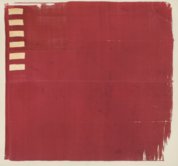
|
Red field with 13 stripes in its corner, 6 on one side (obverse) 7 on the other (reverse) | Earliest surviving flag depicting the 13 colonies with stripes. This flag was used by the Manchester militia during the battle of Lexington in 1775.[29] |
| Washington's Headquarters Flag | 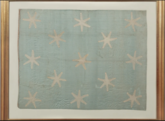
|
2 x 3 ft. blue silk flag with 13 white, 6 pointed stars arranged in a 3-2-3-2-3 pattern | This flag, currently in possession of the Museum of the American Revolution, is claimed to have been used by George Washington during the Revolution.[30] |
| Fort Independence Flag | 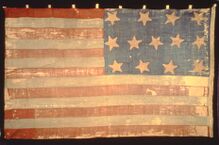
|
6 x 9 ft. Flag with 13 stripes and a blue canton with stars formed in a
4-5-4 pattern. |
One of the few surviving American flags from the revolution, this flag, made in 1781, was said to have been flown over Fort Independence in the late 18th century.[31] |
| Star-Spangled Banner Flag | 
|
30 x 34 ft. (Currently) flag with 15 stripes, 14 stars (one missing)
Stars are arranged in a staggered 3-3-3-3-3 pattern |
Flag that flew over Fort McHenry during a British bombardment in the War of 1812. This flag is depicted by Francis Scott Key in the song "Star-Spangled Banner" which would later become the national anthem of the United States.[32] |
| "Old Glory" Flag | 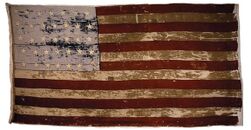
|
12 x 24 ft. American Flag with 34 stars (added later) and an anchor in the bottom right of the canton. | This flag was the first American Flag to be given the name "Old Glory". The flag was made in 1824 and was a gift to William Driver, a sea captain, by his mother. He named the flag 'Old Glory' and took it with him during his time at sea. In 1861 the flag's original stars were replaced with 34 new ones and an anchor was added in the corner of the canton. During the Civil war, Driver hid his flag until Nashville became under union hands, to which he flew the flag above the Tennessee capitol building.[33] |
| Matthew Perry Expedition Flag | 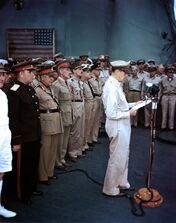
|
Mid-19th century American Naval Ensign with 31 white stars arranged in a linear pattern. | On July 14, 1853 this flag was raised over Uraga, Japan during the Perry Expedition, in doing so it became the first American Flag to officially fly in mainland Japan. In 1855 it was presented to the US Naval Academy. In 1913 it received a linen backing during preservation treatments by Amelia Fowler, who would also work on restoring the Star-Spangled Banner. Nearly a century after its historic voyage to Japan, in 1945 the flag once again returned and was present at the formal surrender of Japan on board the USS Missouri on September 2, 1945. Owing to its condition it had to be presented on its reverse side. Today the flag is in the possession of the US Naval Academy.[34] |
| Fort Sumter Flag | 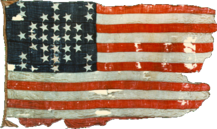
|
Large military storm flag with 33 stars arranged in a diamond pattern. | During the bombardment of Fort Sumter in April 1861, the pole this flag was on was hit by artillery fire. The flag was raised again from a makeshift pole but was taken down after the union garrison surrendered. Before departing, it was agreed that the union artillery could fire a gun salute for the flag. The flag was taken by the union commander of the fort and was shown extensively throughout the north. This flag quickly spurred on wave of what can be called "flagmania" in the north as the American flag began to become much more prominent in Americans lives. Four years after the flag had come down from the fort it once again flew over the fort on April 14, 1865. Later that day Abraham Lincoln would be assassinated.[35] |
| Lincoln assassination Flag | 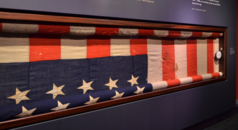
|
36 star American flag with blood of Abraham Lincoln visible on its 8th, 9th and 10th stripe. | This flag was placed under the head of President Abraham Lincoln following his fatal shooting while he was still in the presidential box.[36] |
| Little Big Horn Guidon | 
|
27.5 by 33 in. Silk Guidon flag with 34 gold painted stars (one missing) arranged in a circle.
Stained blood from the battle might also be on the flag. |
This guidon was used by the 7th US Cavalry during the Battle of Little Big Horn in 1876. The battle is infamous, for all US cavalry troops engaged in battle were killed, including Lt. Col George A. Custer. This flag was discovered by Sgt. Ferdinand Culbertson under the body of one of the slain soldiers.[37] In 2010, this flag was sold for $2.2 million.[38] |
| Iwo Jima Flag | 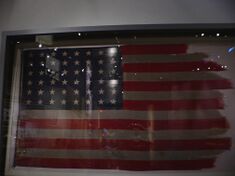
|
4.67 x 8 ft. 48 star American flag with fly end torn. | This American flag was raised above Mount Suribachi during the Battle of Iwo Jima in WW2. The photo of this flag being raised by US Marines was captured in the 1945 Pulitzer Prize winning photo "Raising the flag on Iwo Jima".[39] |
| First American Flag in space | 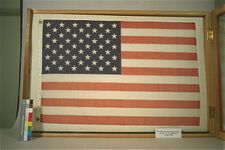
|
23 x 36 in. 50 star American Flag made of cloth. | This American Flag flew on the Freedom-7 mission to space, becoming the first American flag to leave the Earth's atmosphere. The flag was a last minute addition after a local student council president asked a reporter if this flag could be taken on board. The reporter took it to the head of the NASA space task group to which he agreed. In 1995, the flag was taken to space once again for commemorating the 100th American manned space mission.[40] |
| "Raising the Flag at Ground Zero" Flag | 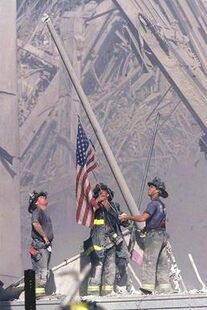
|
3 x 5 ft. 50 star American Flag | Following the collapse of the Twin Towers at the World Trade Center on September 11, 2001, this flag, which had been on board a yacht, was attached and raised on a tilted flag pole by three members of the New York City Fire Department, Dan McWilliams, Billy Eisengrein, and George Johnson. This event was photographed and helped boost morale, similar to the "Raising the Flag on Iwo Jima" photo.[41] It is currently in the possession of the 9/11 Memorial & Museum. |
Related flags
- The flag of Bikini Atoll is symbolic of the islanders' belief that a great debt is still owed to the people of Bikini because in 1954 the United States government detonated a thermonuclear bomb on the island as part of the Castle Bravo test.[42]
- The Republic of the United States of Brazil briefly used a flag inspired by the U.S. flag between 15-19 November 1889, proposed by the lawyer Ruy Barbosa. The flag had 13 green and yellow stripes, as well as a blue square with 21 white stars for the canton. The flag was vetoed by the then provisional president of Brazil citing concerns that it looked too similar to the American flag.[43]
- The flag of Liberia bears a close resemblance, showing the origin of the country in free people of color from North America and primarily the United States.[44] The Liberian flag has 11 similar red and white stripes, which stand for the 11 signers of the Liberian Declaration of Independence, as well as a blue square with only a single large white star for the canton. The flag is the only current flag in the world modeled after and resembling the American flag, as Liberia is the only nation in the world that was founded, colonized, established, and controlled by settlers who were free people of color and former slaves from the United States and the Caribbean aided and supported by the American Colonization Society beginning in 1822.[45]
- Despite Malaysia having no historical connections with the U.S., the flag of Malaysia greatly resembles the U.S. flag. It is possible that the flag of the British East India Company influenced both the Malaysian and U.S. flag.[9]
- The flag of El Salvador from 1865 to 1912. A different flag was in use, based on the flag of the United States, with a field of alternating blue and white stripes and a red canton containing white stars.[46]
- The flag of Brittany was inspired in part by the American flag.[47]
انظر أيضاً
أقسام من مقالات
أشخاص مرتبطون
- Robert Anderson (1805–1871), lowered the Fort Sumter Flag, which became a national symbol, and he a hero
- Francis Bellamy (1855–1931), creator of the Pledge of Allegiance
- Thomas E. Franklin (1966–present), photographer of Ground Zero Spirit, better known as Raising the Flag at Ground Zero
- Christopher Gadsden (1724–1805), after whom the Gadsden flag is named
- Jasper Johns (born 1930), painter of Flag (1954–55), inspired by a dream of the flag
- Katha Pollitt (1949–present), author of a controversial essay on post-9/11 America and her refusal to fly a U.S. flag
- George Preble (1816–1885), author of History of the American Flag (1872) and photographer of the Fort McHenry flag
- Joe Rosenthal (1911–2006), photographer of Raising the Flag on Iwo Jima
المصادر
- ^ "The 50-star flag turns 60 years old". Washington Examiner. July 4, 2020.
- ^ John Warner (1998). "Senate Concurrent Resolution 61" (PDF). U.S Government Printing Office. Retrieved April 5, 2014.
- ^ "History of the American Flag". www.infoplease.com. Retrieved December 13, 2015.
- ^ During the Revolutionary War era, the "Rebellious Stripes" were considered as the most important element of United States flag designs, and were always mentioned before the stars. The "Stripes and Stars" would remain a popular phrase into the 19th century. Credit for the term "Stars and Stripes" has been given to the Marquis de Lafayette. See Mastai (1973), pg. 29.
- ^ "USFlag.org: A website dedicated to the Flag of the United States of America - "OLD GLORY!"". www.usflag.org. Retrieved December 13, 2015.
- ^ Duane Streufert. "A website dedicated to the Flag of the United States of America – The 50 Star Flag". USFlag.org. Retrieved September 12, 2013.
- ^ أ ب Leepson, Marc (2004). Flag: An American Biography.
- ^ أ ب Ansoff, Peter (2006). "The Flag on Prospect Hill" (PDF). Raven: A Journal of Vexillology. 13: 91–98. doi:10.5840/raven2006134. Archived from the original (PDF) on فبراير 5, 2015.
- ^ أ ب The Striped Flag of the East India Company, and its Connexion with the American "Stars and Stripes" at Flags of the World
- ^ East India Company (United Kingdom) at Flags of the World
- ^ Johnson, Robert (2006). Saint Croix 1770–1776: The First Salute to the Stars and Stripes. AuthorHouse. p. 71. ISBN 978-1425970086.
- ^ Horton, Tom (2014). "Exposing the Origins of Old Glory's stripes". History's Lost Moments: The Stories Your Teacher Never Told You. Vol. 5. Trafford Publishing. ISBN 978-1490744698.
- ^ أ ب "Saltires and Stars & Stripes". The Economic Times. September 22, 2014. Retrieved 2017-05-23.
- ^ "Washington Window". Archived from the original on February 4, 2013. Retrieved April 25, 2013.
- ^ أ ب Vile, John R. (2018-10-31). The American Flag: An Encyclopedia of the Stars and Stripes in U.S. History, Culture, and Law (in الإنجليزية). ABC-CLIO. p. 342. ISBN 978-1-4408-5789-8.
- ^ أ ب Leepson, Marc (2007-04-01). "Chapter Ten: The Hundredth Anniversary". Flag: An American Biography (in الإنجليزية). Macmillan. ISBN 978-1-4299-0647-0.
- ^ Capps, Alan. "Coat of Arms". The Digital Encyclopedia of George Washington (in الإنجليزية). Mount Vernon Ladies' Association. Retrieved 2020-01-08.
- ^ (For alternate versions of the flag of the United States, see the Stars of the U.S. Flag page Archived فبراير 22, 2005 at the Wayback Machine at the Flags of the World website.)
- ^ Leepson, Marc. (2005). Flag: An American Biography. New York: St. Martin's Press.
- ^ أ ب "United States Department of State Identity and Marking Standards" (PDF). Bureau of Educational and Cultural Affairs. June 2012. Retrieved 2021-06-18.
- ^ Note that the flag ratio (B/A in the diagram) is not absolutely fixed. Although the diagram in Executive Order 10834 gives a ratio of 1.9, earlier in the order is a list of flag sizes authorized for executive agencies. This list permits eleven specific flag sizes (specified by height and width) for such agencies: 20.00 × 38.00; 10.00 × 19.00; 8.95 × 17.00; 7.00 × 11.00; 5.00 × 9.50; 4.33 × 5.50; 3.50 × 6.65; 3.00 × 4.00; 3.00 × 5.70; 2.37 × 4.50; and 1.32 × 2.50. Eight of these sizes conform to the 1.9 ratio, within a small rounding error (less than 0.01). However, three of the authorized sizes vary significantly: 1.57 (for 7.00 × 11.00), 1.27 (for 4.33 × 5.50) and 1.33 (for 3.00 × 4.00).
- ^ Ex. Ord. No. 10834, August 21, 1959, 24 F.R. 6865 (governing flags "manufactured or purchased for the use of executive agencies", Section 22). Section 32 explains that, "As used in this order, the term 'executive agencies' means the executive departments and independent establishments in the executive branch of the Government, including wholly owned Government corporations."
- ^ Architect of the Capitol: "Flag Request Form", retrieved on July 1st, 2017.
- ^ General Services Administration "Federal Specification DDD-F-416F: Flag, National, United States of America and Flag, Union Jack". March 31, 2005.
- ^ Genevieve Reimann, Deane B. Judd, and Harry J. Keegan (1946). "Spectrophotometric and Colorimetric Determination of the Colors of the TCCA Standard Color Cards". JOSA 36 (3), 128–159.
- ^ In the 9th edition of the Standard Color Card of America, "White", "Old Glory Red", and "Old Glory Blue" were, respectively, Cable No. 70001, Cable No. 70180, and Cable No. 70075. The Munsell renotation coordinates for these were taken directly from the Reimann et al. paper, the CIELAB D65 coordinates were found by converting the xyY values in that paper to be relative to CIE Illuminant D65 from Illuminant C using the CAT02 chromatic adaptation transform, and relative to a perfect diffuse reflector as white. The "relative" values in the table were found by taking Cable No. 70001's luminosity to be that of the white point, and were converted to D65 or D50 also using the CAT02 transformation. The values for CMYK were found by converting from the CIELAB D50 values using the Adobe CMM and the GRACoL 2006 ICC profile in Adobe Photoshop.
- ^ "Flag Folding Ceremony Air Force Script" (PDF). Archived from the original (PDF) on فبراير 17, 2013. Retrieved ديسمبر 25, 2012.
- ^ "Flag-Folding Procedures | The American Legion". Legion.org. Retrieved September 8, 2013.
- ^ "The Forster Flag – Manchester Historical Museum" (in الإنجليزية الأمريكية). Retrieved 2021-04-22.
- ^ "George Washington's Headquarters Flag". www.amrevmuseum.org (in الإنجليزية). Retrieved 2021-04-22.
- ^ malegislature.gov https://malegislature.gov/VirtualTour/Artifact/8. Retrieved 2021-04-22.
{{cite web}}: Missing or empty|title=(help) - ^ "Star-Spangled Banner". Smithsonian Institution (in الإنجليزية). Retrieved 2021-04-22.
- ^ "Old Glory flag". National Museum of American History (in الإنجليزية). Retrieved 2021-04-22.
- ^ "Object 89: Perry's Flag, Present at Japanese 1853 Opening & WWII Surrender". www.usna.edu (in الإنجليزية). Retrieved 2021-05-14.
- ^ "Battle of Fort Sumter, April 1861 (U.S. National Park Service)". www.nps.gov (in الإنجليزية). Retrieved 2021-05-14.
- ^ "Artifact of the Assassination: The Lincoln Flag and the Gourlay Family". Fords Theatre (in الإنجليزية). Retrieved 2021-04-22.
- ^ "Custer's last flag: Banner carried at Little Bighorn sells for $2.2M". www.cnn.com (in الإنجليزية). Retrieved 2021-04-23.
- ^ "Custer's 'Last Flag' sells for $2.2 million". NBC News (in الإنجليزية). Retrieved 2021-05-21.
- ^ "Iconic Artifacts". National Museum of the Marine Corps (in الإنجليزية). Retrieved 2021-04-23.
- ^ "Flag, United States, Freedom 7 Flight". Smithsonian Institution (in الإنجليزية). Retrieved 2021-04-23.
- ^ "Flag".
{{cite web}}: CS1 maint: url-status (link) - ^ "Bikinian Anthem & Flag". Bikiniatoll.com. March 1, 1954. Retrieved September 8, 2013.
- ^ Um estudo histórico perceptual: A Bandeira Brasileira sem Brasil Archived 2011-07-26 at the Wayback Machine Seysell, Ricardo. Universidade Estadual Paulista), 2006. Retrieved on 10 October 2010. (in برتغالية).
- ^ "President Sirleaf Worships at Abyssinian Baptist Church; Pleads with African Americans to Serve as Ambassadors for Liberia". Ministry of State Presidential Affairs, Executive Mansion, Government of Liberia. September 23, 2012. Retrieved July 16, 2014.
- ^ Eric Burin (2008). Slavery and the Peculiar Solution: A History of the American Colonization Society. University Press of Florida. pp. 20–28. ISBN 978-0813032733.
- ^
Arbizú, Gregorio (4 May 1865). "Decreto del Gobierno designado los colores del pabellón nacional y atributos del escudo de armas de la república" (PDF). El Constitucional (Diario Oficial) (in Spanish). 1 (82): 1 (14 in Archives). Archived from the original (PDF) on 14 June 2021. Retrieved 14 June 2021.
{{cite journal}}: CS1 maint: unrecognized language (link) - ^ Regionalism after Regionalisation (AUP Dissertation Series). Amsterdam University Press; 01 edition (9 Feb. 2014). 2014. p. 223. ISBN 978-9056294281.
المراجع
- Allentown Art Museum. The American Flag in the Art of Our Country. Allentown Art Museum, 1976.
- Herbert Ridgeway Collins. Threads of History: Americana Recorded on Cloth 1775 to the Present. Smithsonian Institution Press, 1979.
- Grace Rogers Cooper. Thirteen-star Flags: Keys to Identification. Smithsonian Institution Press, 1973.
- David D. Crouthers. Flags of American History. Hammond, 1978.
- Louise Lawrence Devine. The Story of Our Flag. Rand McNally, 1960.
- William Rea Furlong, Byron McCandless, and Harold D. Langley. So Proudly We Hail: The History of the United States Flag. Smithsonian Institution Press, 1981.
- Scot M. Guenter, The American Flag, 1777–1924: Cultural Shifts from Creation to Codification. Fairleigh Dickinson University Press. 1990. online
- George E. Hastings. The Life and Works of Francis Hopkinson. University of Chicago Press, 1926.
- Kevin Keim & Peter Keim. A Grand Old Flag: A History of the United States through its Flags. DK Publishing. 2007. ISBN 978-0-7566-2847-5.
- Flag: An American Biography. Thomas Dunne Books/St. Martin's Press, 2005.
- David Roger Manwaring. Render Unto Caesar: The Flag-Salute Controversy. University of Chicago Press, 1962.
- Boleslaw Mastai and Marie-Louise D'Otrange Mastai. The Stars and the Stripes: The American Flag as Art and as History from the Birth of the Republic to the Present. Knopf, 1973.
- Henry W. Moeller, Ph.D. "Two Early American Ensigns on the Pennsylvania State Arms." NAVA News, Issue 173, Jan.–Mar. 2002.
- Milo Milton Quaife. The Flag of the United States. 1942.
- Milo Milton Quaife, Melvin J. Weig, and Roy Applebaum. The History of the United States Flag, from the Revolution to the Present, Including a Guide to Its Use and Display. Harper, 1961.
- Richard S. Patterson and Richardson Dougall. The Eagle and the Shield: A History of the Great Seal of the United States. U.S. Government Printing Office, 1978 [1976 i.e. 1978].
- Albert M. Rosenblatt. "Flag Desecration Statutes: History and Analysis", Washington University Law Quarterly 1972: 193–237.
- George and Virginia Schaun. "Historical Portrait of Mrs. Mary Young Pickersgill." The Greenberry Series on Maryland, Greenberry Publications. Volume 5.
- Leonard A. Stevens. Salute! The Case of The Bible vs. The Flag. Coward, McCann & Geoghegan, 1973.
- Arnaldo Testi. Capture the Flag: The Stars and Stripes in American History (New York University Press; 2010) 192 pages. A European perspective on the symbolism and political, social, and cultural significance of the flag.
- Earl P. Williams Jr. " NAVA News, Issue 216, Oct.–Dec. 2012.
- Paul M. Zall. "Comical Spirit of Seventy-Six: The Humor of Francis Hopkinson." The Huntington Library, 1976.
- Chadwick, Patricia. "The Women Behind the Flag"
قراءات إضافية
- "Identity and Marking Standards" (PDF). Office of the Under Secretary for Public Diplomacy and Public Affairs. Washington, D.C.: United States Department of State. June 2012. Archived from the original (PDF) on February 14, 2013. Retrieved February 14, 2013.
وصلات خارجية
- United States at Flags of the World
- Encyclopedia Smithsonian: Facts About the United States Flag
- Text of the United States Flag Code (chap. 1 of Title 4 of the United States Code)
- Executive Order No. 10798, with specifications and regulations for the current flag
- July 1942: United We Stand – National Museum of American History online exhibition highlighting some 500 magazines featuring the American flag on their cover during World War II
- الصفحات التي تستخدم سمات enclose مهجورة
- CS1 الإنجليزية الأمريكية-language sources (en-us)
- CS1 errors: missing title
- CS1 errors: bare URL
- CS1 maint: url-status
- Articles with برتغالية-language sources (pt)
- CS1: Julian–Gregorian uncertainty
- Short description is different from Wikidata
- Articles with hatnote templates targeting a nonexistent page
- كل المقالات بدون مراجع موثوقة
- كل المقالات بدون مراجع موثوقة from April 2021
- أعلام الولايات المتحدة
- أعلام وطنية
- الرموز الوطنية للولايات المتحدة
- أعلام طرحت في 1777
